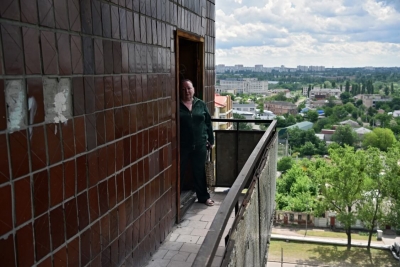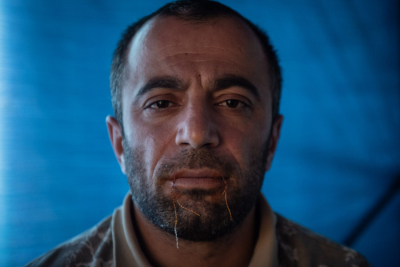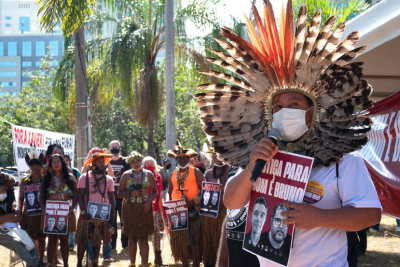The irritating smell, however, carries far beyond the boundaries of the district. The situation is worst at night, when the smell finds its way into apartments, even though their windows are closed. According to data published by the Kharkov journal (Civic Position) in May 2017, the plants emit more than 800 tons of poisonous substances per year: 240 tons of sulphur dioxide, 50 tons of hydrocyanic acid, 200 tons of formaldehyde, and other carcinogenic substances. Every year this city with a population of 1,439,036, 6000 people die of cancer.
“In my building, twelve of my neighbors have died of cancer in the last five years,” says Elena Reshetko, a pensioner and resident of the Novobavarskyi district in Kharkiv. She can see the Kharkiv Coke Plant from the balcony of the flatblock whenever she walks to a plastic tank for water in the middle of the high-rise estate where she has lived for 32 years. She suffers from asthma, like her daughter. Her grandson was diagnosed with a blood disorder. On a table in her small apartment, she preserves all the necessary medications, which she has been dependent on for many years. A considerable part of her pension goes to medical care. Like the vast majority of her neighbours, Elena can’t afford to move away. So she remains in the most polluted part of Kharkiv and spends all her free time and energy on the struggle with two obsolete enterprises.
“As an accountant, I’m used to working with numbers
but there is almost no relevant data on pollution in Ukraine.”
Shocking disease statistics
“People here cannot rely on the authorities, the ministry, or the environmental inspectorate. I wanted to understand what’s going on in my neighbourhood and what exactly is killing us, so I decided to use my accounting skills,” explains Reshetko, as she shows us many notes from her long-term research.
Together with other activists, Reshetko requested official statistics from the Kharkiv clinics for different types of illnesses in adults and children in the years 2010, 2011, 2012, and 2013, and then examined the situation in different parts of the city. When comparing Kharkiv Clinic No. 22 in the Chervonozavodskiy district (which is adjacent to the Zhovteniy district, where the Kharkiv Coke Plant and Termolife are situated), with Kharkiv Clinic No. 9, located 10 km from the plants, it turned out that the incidence of pulmonary and bronchial disease in adults is almost 3078 times higher than those in the area distant from the city. For other diseases, the difference is 15-20 times higher. Diseases of the blood, skin diseases, the circulatory system, and abnormalities in children in the affected area are four times higher than in the remote area. The number of children born with birth defects that include cerebral palsy, bronchial asthma, diseases of the circulatory system, and deaf-muteness is 4.5 times higher per year in the area affected by the plants. Statistics for adult mortality demonstrated that death from cancer in the emission zone for the period from 2003 is 40 times more common in comparison to the indicators for the remote area of the city.
Death threats came soon
Since 2012, Reshetko has been trying to sue for the damage to her health and violation of her right to live in a safe environment. The court has not reached a verdict yet because of the lack of evidence of the link between the diseases and the pollution emitted by the plants into the air. She encouraged many neighbors from the district to come together when she founded the Ekocid NGO in 2013. They turned to the authorities, organized demonstrations, and wrote petitions and open letters to the governor. They even blocked the road track used for bringing coal to the plant. Although this long struggle yielded no results, Reshetko endured harassment: someone has cut off the electricity in her flat several times, the door of her apartment was glued shut, and one day she received death threats-– graffiti written on the wall of the corridor. Her neighbors supported her; however, as the plant employs about 700 people, not all residents of the Novobavarskyi district who are exposed to extreme pollution stand with the activists.
“The plants are situated in the low-lying areas, so dangerous
substances accumulate in the valley and the inhabitants have to inhale them.
We observe here all the symptoms of environmental disaster: pollution of the atmosphere, water, and soil.”
Despite the threats and lengthy court proceedings, the pensioner continued her research. Soon she came up with another interesting discovery: untreated wastewater from the Kharkiv Coke Plant from the back of the plant, which is guarded by armed security men, polluting the soil of the territory of the mineral deposit and the Udy River. Thus, we have a paradoxical situation in which valuable water is used for coke production, while ordinary Kharkiv people pay for drinking water at the price of approximately 9.00 UAH per cubic metre. To understand how this is possible, we have to look back at the history.
Valuable mineral water used for coke quenching
The experimental laboratory of Giprokoks (Гипрококс), a state-owned firm, was built in Kharkiv in 1932 as a coke research center. Its ovens ceased operation in 1952, but in 2003 its new owners began coke production once more. They illegally gained access to the valuable Novozhanov mineral water deposit. Now, potable publicly-owned mineral water is used in large volumes for quenching coke. Located 8 kilometres from the Kharkiv Coke Plant, the Berminvody, Rosha, and Ray-Elenovka sanatoria have mineral water with a similar composition. The source of the drinking water falls under the State Geological and Mineral Resources Survey (Derzhgeonadra) of Ukraine, to which Reshetko sent an official request for the release of contracts allowing access to the area of the valuable water deposit, along with the necessary authorization. Derzhgeonadra replied that no rental permit or permit for the construction of facilities was ever issued to either plant, and this was later confirmed by the Oktjabr's court in Kharkiv.
Traces lead to Donetsk
In 2017, the Ukrainian TV channel Kanal 24 broadcast a report detailing the ownership structure of the Kharkiv coke plant and the Termolife plant. Traces led to an offshore destination in Cyprus and to occupied Donetsk. Although Ukraine imposed a full economic blockade of the occupied territories in February 2017, Kanal 24 showed evidence of the importation of coal from Donetsk into the Kharkiv coke plant in summer 2017.
Status as of February 2018
Further reading
UKR 17/02/2012 Why it is impossible to prevent toxic emissions of Kharkiv "Koksokhim" (Deutsche Welle)
Videos:
UKR 22/07/2017 How a coke plant in Kharkiv poisons the lives of local people (24Kanal - YouTube)





